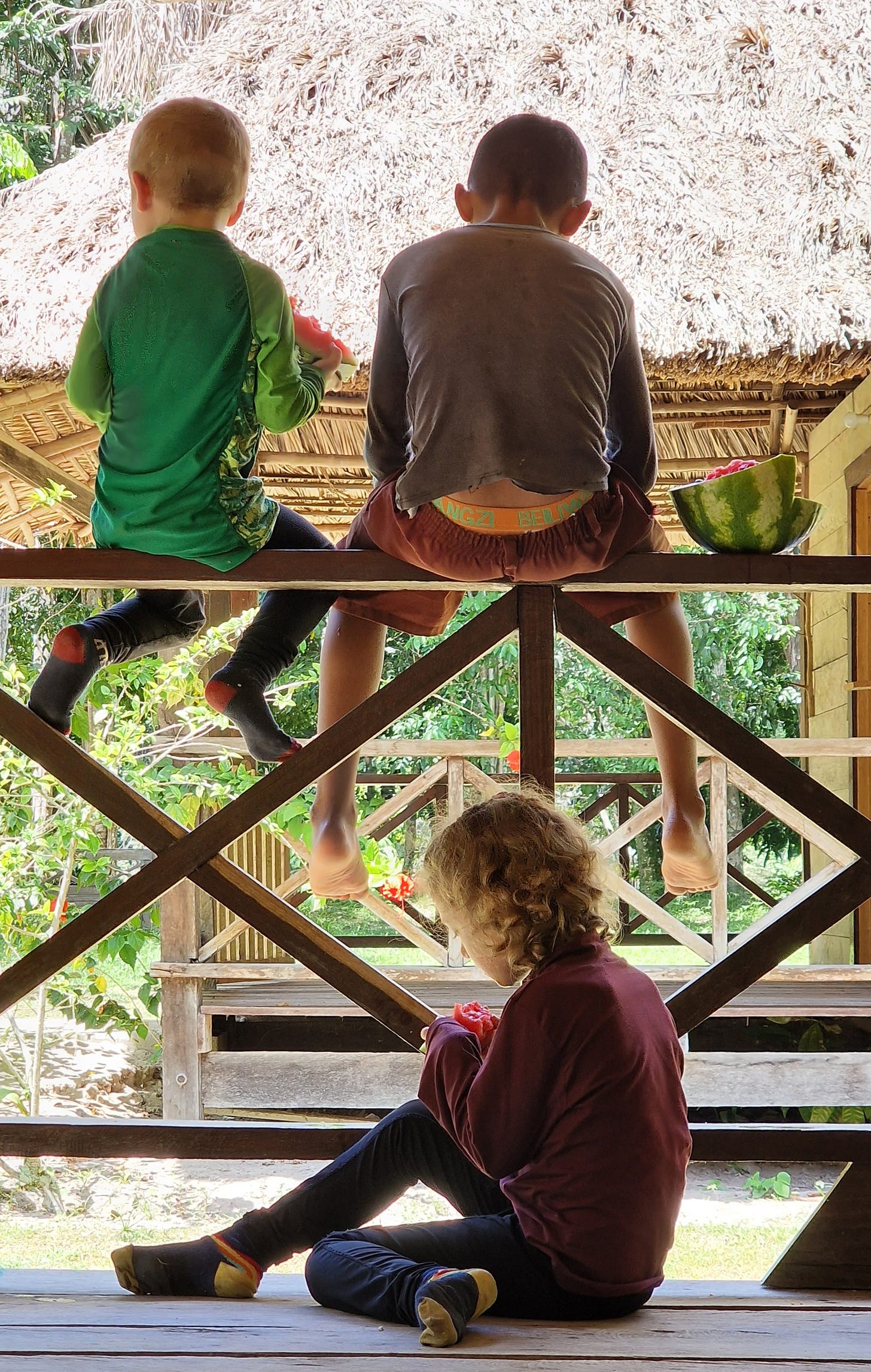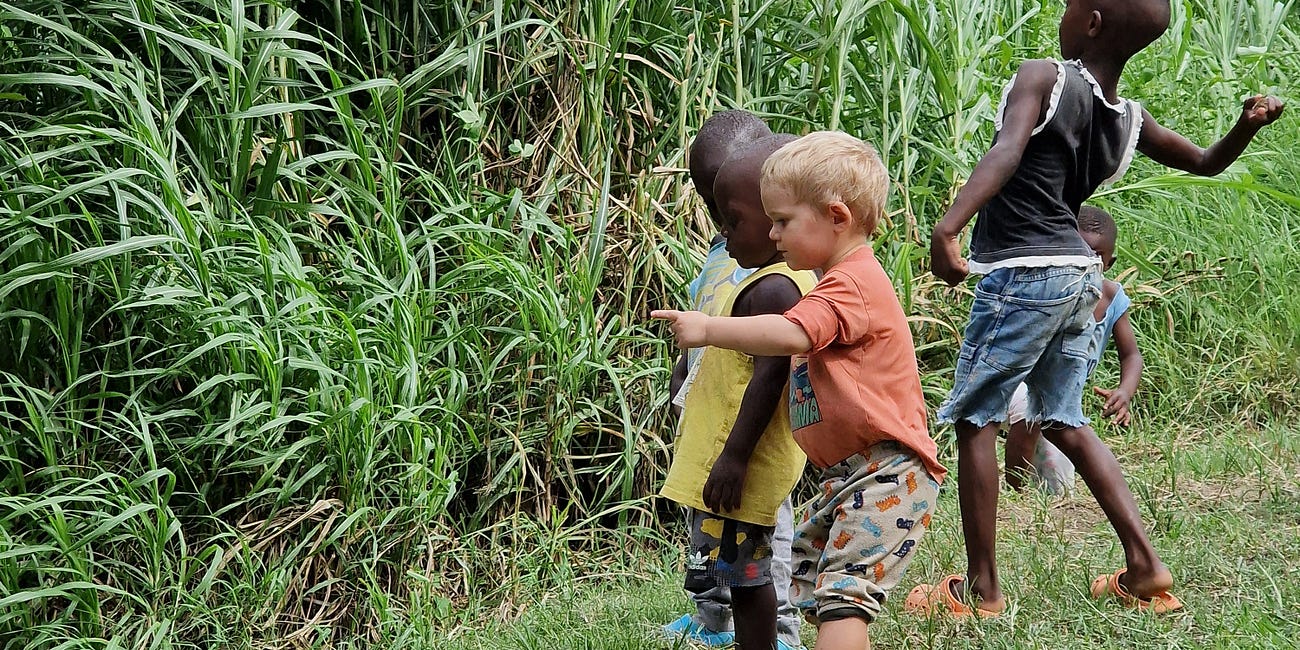How do children's clothes affect how they move?
How the clothes our kids wear influence how their bodies grow
The peace and harmony of the mid-day lull shattered as children tumbled around the corner, shrieking and yelling. The tiny blue birds scattered from the house’s old stone steps in all directions, like shards of a dropped glass vase. No chance of sweeping up these pieces - chaos had arrived and the peace had fled back into the forest.
Chaos, without stopping to say hello, set about lighting a small fire.
It was cashew nut season and the children (ours, and six Gambians they’d met out and about) had been out climbing trees, picking fruit, twisting the green-grey bean-shaped pods from the underside, and were now preparing to burn away the toxic outer shell, and share the tasty nuts inside.
I noticed that a few of them had taken off their t-shirts to tie them into sacks to carry the group’s precious cargo. Everyone else was still showing the typos and uneven seams that subtly marked out their clothing as European offcasts. Manufacturing waste written off as charity donations by large companies keen to dodge tax. It’s a practice that has been going on for decades, and people still debate the ethics of the economics.
But maybe they’re missing the bigger point - When this happens, are we exporting more than just our clothes?
I’d never really thought much about how clothes affected movement until I saw first-hand the effects of clothing on a child with cerebral palsy, who finds movement challenging. If you take away some of the wearer’s ability to cope with physical difficulties, then you get much more obvious feedback. Suddenly it was clear that tight waistbands made sitting on the ground uncomfortable, and tight trouser legs made getting off the ground almost impossible. Non-stretchy tops meant she couldn’t lift her arms above her head. “Footie” pyjamas (those with built-in socks) meant she couldn’t squat without hurting her toes. Even in a wide open space, she was confined.
.
The more my daughter taught me about the challenges of Western clothing, the more I noticed them affecting other children. But, even though their clothes were clearly impeding them, they almost never complained. Why? It appeared that a combination of marginally more ability to cope, and strong societal affirmation that the clothes were in the right (‘No, Timmy, put your trousers back on! We wear trousers at the park!’, ‘Leilei, that’s your new top. Don’t tear it!’ etc. etc.) tipped the balance in favour of children just avoiding movements that brought them into conflict with their clothing.
Have you found yourself saying things like this to your children? How do you select clothing that helps them move?
But that’s a problem. We see that that’s a problem, right? It’s not just less fun to not be able to climb/run/fall over/get back up as easily as nature intended, but for healthy body growth, we need to move in lots of different ways. Each specific movement supports specific parts of the development of our bones, muscles, joints, and nervous systems. Squatting helps develop the muscles that stop you soiling yourself. Swinging your arm above your head appears to helps to deepen the shoulder joint, reducing the risk of shoulder pain later in life. Even a waistband that stops you from inhaling deeply changes the development of your diaphragm and rib muscles, eventually stopping you from ever being able to inhale deeply. Confining developing children is a bad idea.
In many parts of the world, they get a second chances here. If they don’t develop natural movement habits in early childhood, some part of normal life is going to force them to develop them later. Our lifestyle in the WEIRDer (ie. Western, Educated, Industrialised, Rich, and Democratic) is more sedentary. We get no such reprieve. However, that’s not the only problem. Our WEIRD clothing is, in general, a lot more restrictive than that worn in more traditional societies.
Why?
It’s cold. Cold-weather clothes are bulkier and restrict movement more than warm-weather clothes. Clothing isn’t necessary for survival in equatorial regions.
We’re still. We spend most of our time not moving much. As a result there was no problem developing clothing cuts and styles that work for still people. Still joints are rarely flexed, so the measurements rarely leave room to flex easily.
Stretchy fabrics pose challenges. Even cuts for still people could still allow movement if they were made of stretchy fabric. However, stretchy fabrics are harder to make, harder to work with, and last less long: denim compared to Lycra or Spandex, for example.
We don’t think about movement when buying clothes: It’s rarely part of our decision-making process, unless we’re specifically buying clothes for sport or exercise. Adults put up with discomfort for the sake of fashion. And because adults do, children must.
But, if we’re thinking about fashion, then not all clothes are created equal:
Some clothes show the dirt more than others: Dirty clothes are hard to clean and socially taboo. We tell them off for playing in the dirt because it spoils their clothes. (We tell them off for gathering cashew nuts because those darn things stain permanently!). But there’s an uncomfortably gendered thing here… The typical pastel colours of girls’ clothes show the dirt more than the typical bright or dark colours of boys clothes. Yet another way that we tell our daughters that movement is not as important for them - maybe that’s part of why 80% of children classed as ‘very sedentary and inactive’ are girls…
Gendered clothes restrict movement in different ways: Just because boys and girls urinate in different ways, we’ve constructed gender norms about clothes that restrict a child’s movements in gendered ways. (Maybe the urination thing is obvious, but I was surprised when I first noticed this. Who’d’ve thought that our gendered clothing norms are so affected by how easy it is to expose your genitals and avoid weeing on your feet?). Back to clothes. Ever tried to climb a tree in a dress? Or squat in non-stretchy trousers?
Celebration clothes are almost universally uncomfortable: Children’s ‘best’ clothes are usually especially restrictive - think long dresses, ironed shirts, and smart trousers. Maybe that’s because fashion is always about doing something difficult? Nevertheless, from an early age, we teach children that easy, comfortable movement is not a part of celebrations.
Seven reasons and meta-reasons why WEIRD clothes fight against movement. And the effects are obvious. Before you go, ‘Huh, that’s interesting. Next article!’ just pause for a second and think about whether you honestly think that increasing a kid’s risk of decades of joint pain or their odds of breaking a hip in their eighties is worth seeing them in a cutesy miniaturised version of a fashionable shirt. Just soak in that absurdity for a moment. Let it get right on in your pores. Irritated yet? Good.
Cruciate ruptures are up 2000% in UK children since 2000. Why?
Anterior cruciate ligament injuries used to be very uncommon in children. They were the footballers’ injuries - seen in elite sportspeople or unlucky paratroopers.
So what can we, as a society, do? Whether we’re buying for your own kids, drafting school uniform regulations, or designing the next big little thing for H&M, we should:
Pick clothes that let children move. “Adult fabrics” (ie. normal denim, corduroy, etc.) while allowing the construction of very cute outfits, are even more restrictive for children because the fabric is proportionally stiffer against their smaller muscles, and because the stiff (full-size) seams are closer together, reducing the fabric stretch. For kids, jersey knitted fabrics beat woven materials 19 times out of 20.
Teach children to assess their clothes for movement. Can they reach their arms overhead? Can they squat? Can they sit comfortably on the ground? Can they walk easily? Can they breathe normally? If no, we need to give them a chance to say that. And show that we’ll act on their complaints.
Rethink our own concerns about clothes getting dirty or damaged. Kid’s clothes can’t go in the same “I’ll love this outfit forever” mental box as adult clothes. They’re going to grow out of them anyway, we need to assume they’ll get dirty and torn and let that happen. Probably they can be fixed. Possibly this is even something a child could learn to do. There’s a scout badge in there somewhere, I’m sure. Or at least a lifetime of awesome halloween costumes.
Whatever we choose to do, we need to stay committed. The damage done by restricted clothing is insidious and really hard to see. Clothing for children never says ‘Stay still!’. That would, even for Western buyers, be brand suicide. Instead it says, ‘Just don't do this one movement! Don't kneel in these trousers. Don't squat in those shoes. Don't stretch in that blouse.’
Sometimes the punishment for disobedience is pain from constricting material. Sometimes it's sadness at breaking something you like. Sometimes it is getting told off by your mum because she's worried about being judged because your clothes won't look new. The downside of moving in WEIRD clothing is unpredictable, and unpredictability is the single best way to train fear of a thing. In this case, fear of movement.
Being subconsciously a little afraid of movement from childhood is a very subtle way to end up with a body that won’t let you live quite the fullest life you wanted to live.
Let’s help children to build bodies that will keep strong and mobile throughout their lives. Let’s teach our children to regain control of their clothes. Let’s let a little of their chaos shine through.
So. Look again at those three simple ways forward. It starts with us: Check whether children’s clothes will let them move; refuse to accept those that don’t; and make absolutely darned sure that kids don’t accept them either.
Notes
Four months of squatting exercises in bed-wetting children helped 86% of them stop wetting the bed. https://pmc.ncbi.nlm.nih.gov/articles/PMC7587486/
Tight trousers change how people pick things up: https://www.sciencedirect.com/science/article/abs/pii/S0003687013000744
UK survey on children’s activity levels since COVID: https://www.youthsporttrust.org/research-listings/research/who-s-doing-what-how-patterns-of-children-s-physical-activity-have-changed-since-the-pandemic
Katy Bowman’s book ‘Grow Wild’ has a whole chapter on clothes and shoes. Well worth a read.






I have thought about this too – M is very particular about what he will wear (which is basically all the things in which he CAN move freely and none in which he can't), and I generally let him wear the comfy stuff, but I do have to consciously reduce my expectations of smartness in doing so, and I'd love it if there were more comfy clothes that are also smart! I've noticed the other boys at his school wear jeans most days (we don't have uniform). Why has this become the norm? They're neither smart nor good for running around in!
Totally agree but even more fundamentally we need to teach people to move optimally. In WEIRD countries it is noticeable that people's posture is poor from a very early stage - partly due to too much sedentary behaviour, partly due to wearing badly fitting shoes and partly due to feeling self aware about taking up space/moving too much. I frequently notice young people with poor gait and posture and I guarantee that when they are older they will suffer from back, hip and knee problems. It would be useful if rather than just teaching sports, we also taught young people about what it is to move and walk properly. That would save a lot of problems from developing in the future